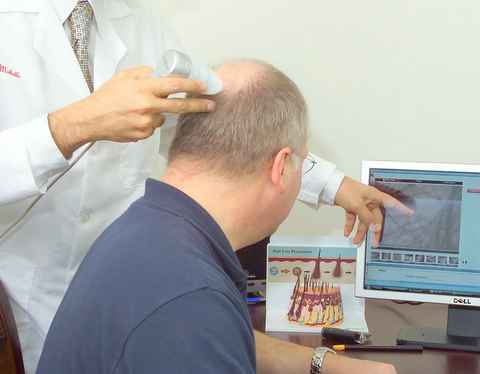Scalp Hair Miniaturization
Updated July 2020
 Miniaturization of scalp hair is a part of the hair loss process in which the hair shafts of a person become finer over time before falling out. Miniaturization always occurs before losing hair in patterned hair loss. In fact, the presence of miniaturization is one of the factors that differentiate typical patterned hair loss from other types of hair loss conditions.
Miniaturization of scalp hair is a part of the hair loss process in which the hair shafts of a person become finer over time before falling out. Miniaturization always occurs before losing hair in patterned hair loss. In fact, the presence of miniaturization is one of the factors that differentiate typical patterned hair loss from other types of hair loss conditions.
Microscopic evaluation of the scalp and hair can help determine the rate of miniaturization on human hair. The amount of balding in men and women is usually not obvious until a significant amount of miniaturization is present.
Scalp miniaturization mapping is necessary for most hair loss patients to predict their future hair loss.
The appearance of baldness on the scalp of a person is not obvious until more than 70% of hair is miniaturized in most people. A miniaturization study should be part of the hair loss evaluation process of a patient and this type of study could be used as a predictor of future balding in a given area of the scalp. Significant hair miniaturization is seen in patients who are in the active phase of hair loss and this evaluation could determine the response of a patient to a certain type of medical treatment.
Microscopic evaluation of scalp hair shows significant miniaturization.
Dr. Mohebi uses a microscope to map the patient’s scalp, using a miniaturization study, as part of the initial hair loss evaluation before starting any medical treatment or performing hair transplant surgery. Young patients with significant miniaturization are prone to losing their vulnerable hair after any trauma or irritation of the area such as hair transplant surgery. This condition is secondary to the stress of surgery on skin and hair follicles. This phenomenon is called shock loss and occurs less in patients with minimal amounts of hair miniaturization.
Dr. Mohebi evaluates all patients for donor density and miniaturization rate in balding and non-balding areas.
Dr. Mohebi consistently tracks his patients through miniaturization studies when they are on a treatment plan to gauge hair gain or hair loss. This allows the doctor to objectively evaluate the effectiveness of their treatment. If you are balding and want to do something about it through hair transplant surgery or a medical treatment, you should have your hair mapped for miniaturization in order to have a baseline assessment of your current hair loss status. This way we can assess the effectiveness of medications and predict which areas will have the most hair loss. This will also help Dr. Mohebi cover areas of future hair loss so that you are not obliged to undergo multiple surgeries to chase the balding hair.
Miniaturization study
Having 10% to 20% miniaturized hair is often considered to be normal and not part of the balding process. Scalp hair goes through two main phases:
- Growth phase (Anagen)
- Resting phase (Telogen)
The growth phase in scalp hair of normal people can take between 1 to 6 years while the resting phase is about 4 to 6 weeks. When we lose one hair to the telogen phase, another hair will grow from its follicle which will be represented by a few tiny hairs showing hair cycling in the area (and not necessarily the balding process).
If we view over 20% hair miniaturization in a general area on the scalp, this is a common indication of active hair loss in the area. Higher numbers of miniaturization could represent active hair loss and a progression of balding in the future. The effects of a medical treatment on baldness are very gradual and may take at least six months for any detectable improvement in the miniaturization of hair.